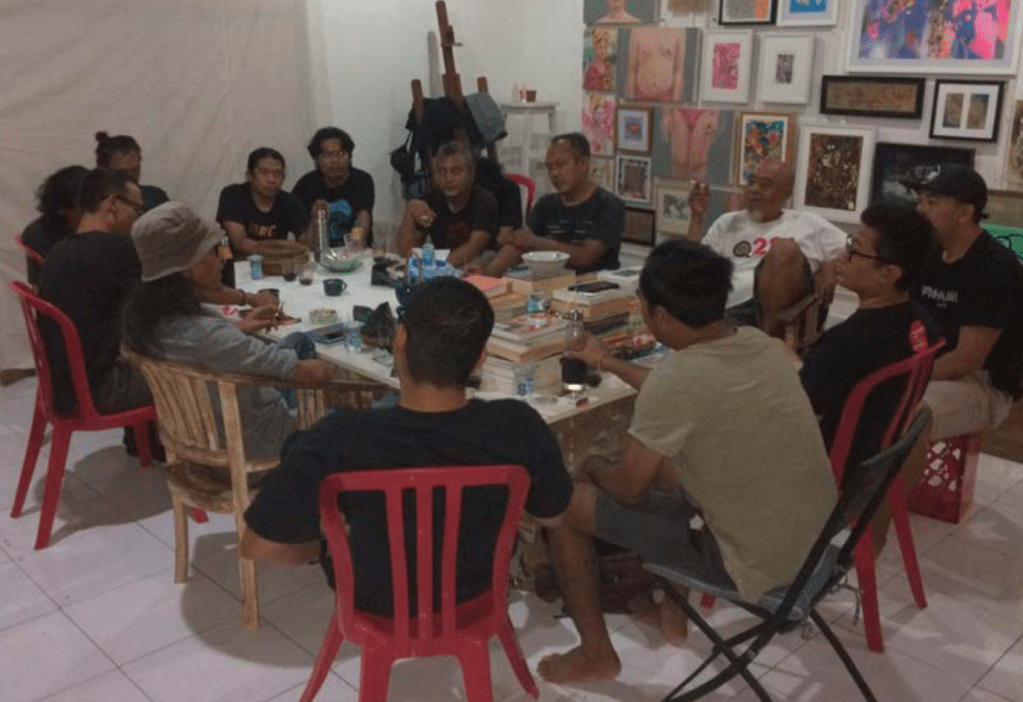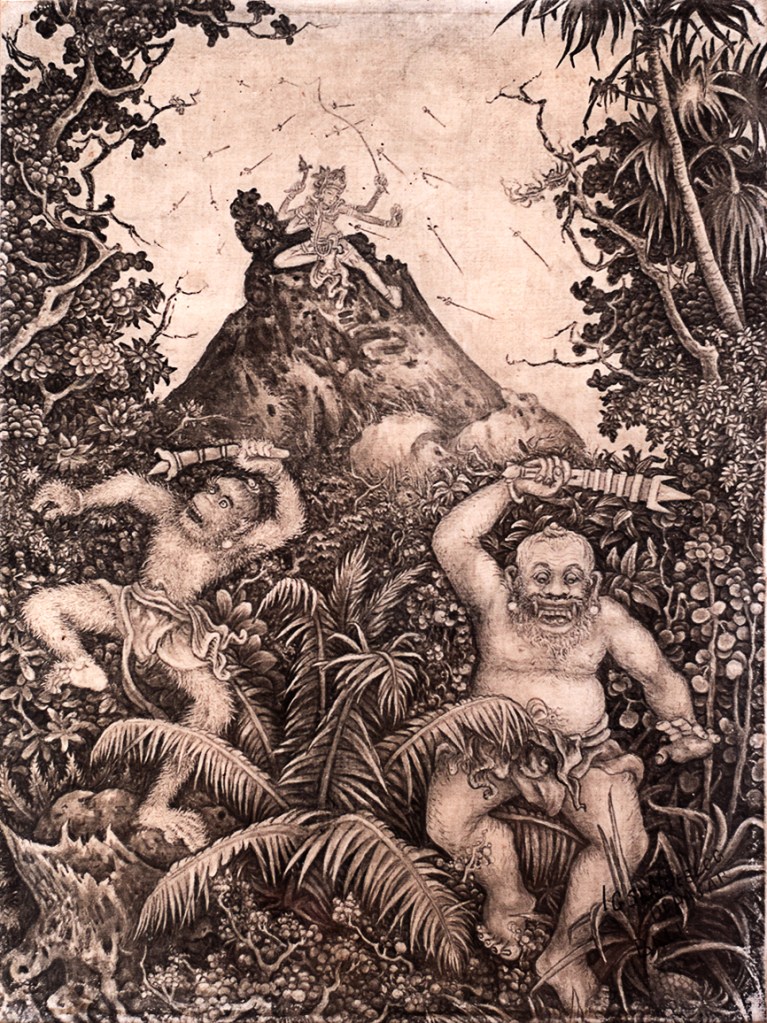
From its inception in 2016, the independent research, archiving, and documentation initiative of the Gurat Institute, led by four young writers, has maintained a unique vision of presenting Balinese art narratives from the voice of the Balinese.
Since the turn of the millennium, Indonesian contemporary art has thrived, though there were some bumps associated with the Global Financial Crisis in 2008. Generally though, artists and the industry have enjoyed increasingly engaged international audiences and collectors. In addition, key developments in the Javanese cultural hubs of Bandung, Yogyakarta and Jakarta have positioned ArtJog, Art Jakarta and the Bandung Contemporary Art Awards on the regional and global art calendar.
Meanwhile, neighbouring Bali’s art scene has remained in the shadows. Traditional Balinese art is a functional aspect of daily life required for sacred cultural and religious purposes. Modern art genres evolved from the 1920s onwards, coinciding with the first wave of international tourism and the development of burgeoning souvenir market in Bali, temporarily interrupted by the Japanese invasion in 1942.

Gurat Institute and friends in discussions at the Gianyar headquaters
The transition of art into styles to suit foreign tastes and the lack of supporting infrastructure to
help distinguish the sacred works consequently led to Balinese art being maligned and categorised as commercial, tourist art. Nowadays, a journey through the Balinese cultural epicentre of Ubud reveals the proliferation of commercial art shops, but information and accessibility to the best traditional and contemporary fine art and its practitioners are not readily available to the tourist masses. Nor are there museum collections that reflect recent developments in art, hence the description of tourist art, especially for first-time visitors, is applicable. However, this perception neglects many significant distinctions, including the sacred classical Balinese Kamasan paintings, the magical rerajahan drawings and the contemporary art developments beginning in the 1970s.
Today a flourishing international art and design scene supported by an evolving local infrastructure offers creative opportunities for fine artists, creatives and foreign audiences
alike. From its inception in 2016, the independent initiative of the Gurat Institute, led by four young writers, has been presenting Balinese art narratives from the voice of the Balinese. Dedicated to research, archiving, publishing, artist-in- residency programs, workshops
and exhibitions.

Wayan Redika ‘Heritage’ 2022 Natural Balinese Colours on Ulantaga paper. Image courtesy Gurat Art Project
As Gurat founder Wayan Seriyoga Parta put it,… the Gurat Institute was established stemmed from personal anxiety. There were too few Balinese willing to become art writers with the devotion to strive for long-term outcomes; to write, curate and research the development and history of Balinese art. I invited Dewa Purwita, Made Susanta and Wayan Nuriarta to discuss the issues of writing and researching Balinese art in 2013. We agreed to collaborate on projects exploring cultural values.
Lempad & Deblog: early innovators
The Institute’s initial endeavour was Lempad for the World, a biography written by Gusti Putu Sutedja, Ketut Budiana and Made Susanta Dwitanaya and published in 2014 on I Gusti Nyoman Lempad (1862–1978), an architect, stone sculptor and master of ink painting who became Ubud’s best known artist and local cultural ambassador. Following this was I Gusti Made Deblog – Master Seni Lukis Naturalis Dalam Medan Seni Rupa Denpasar – Bali (Master of Naturalist Painting in the Field of Fine Arts), a biography and film on Denpasar painter I Gusti Made Deblog (1910–1986) by Wayan Seriyoga Parta, Dewa Gede Purwita and Made Susanta Dwitanaya, supported by Indonesia’s Ministry of Cultural Education.

I Gusti Made Deblog – Master Seni Lukis Naturalis Dalam Medan Seni Rupa Denpasar – Bali (Master of Naturalist Painting in the Field of Fine Arts) Book Cover.
Renowned as an innovator during the golden years of Balinese painting from 1930–42, Deblog devised a captivating, pictorial world merging the Sekala and Niskala, the visible and invisible elements of the environment, into a revolutionary, otherworldly aesthetic, which became known as the ‘the Iconic Naturalist Deblog Style.’ The development of modern Balinese art was generally portrayed as Ubud-eccentric. The focus was on celebrated Ubud artists of the Pita Maha Arts Society, such as Sobrat (1912–1992), Kobot (1917–1999) and Lempad (1862–1978). Politically biased propaganda, anchored in Dutch colonialism, circulated about the development of Balinese art with Ubud at its epicentre.
“The lack of documentation on the masters of the Pita Maha [group] motivated our extensive study, a biography and description of Deblog’s achievements. Denpasar was the initial locus of art development from the turn of the twentieth century,” said Seriparta Yoga.

SEMARADAHANA – Gusti Deblog, circa 1940.50x35cm.Tinta Cina diatas Kanvas(koleksi Griya Delod Pasar Sanur)
The catalogue bridges over fifty years of work, with sketches, photographs and an analysis of Deblog’s style and material techniques. Comparisons are made between Ubud-based Lempad’s drawings and the techniques of the Batuan School of Painting. Deblog
is known for his achievements in Chinese ink media, commonly used by Balinese painters in his day. However, his technique varies from that of Balinese painters who generally use the sigar mansi technique, as in the Ubud and Batuan areas. Whereas the catalogue attempts to recreate the artistic atmosphere of Denpasar and the creative environment of influential local painters who set the stage for Deblog, the film highlights Gurat’s method, offering insights into their six-year investigative task. Gurat’s research offers a landmark in the development of Balinese art, being the first in-depth examination of the artist conducted by an independent, locally-based Balinese institution. As Seriyoga Parta notes, the example of ‘Deblog’s research provides valuable opportunities to discuss the development of art in Denpasar in a broader aspect.’
Warna Bali: Natural Balinese Colors in The Contemporary Art
In June 2021, Gurat began an inclusive study on the traditional knowledge system of Balinese colour; rich in philosophical significance, colour unifies the invisible and physical realms which defines the people’s relationship with nature and the macro cosmos. Warna Bali: Natural Balinese Colors in The Contemporary Art, showed in October–November, 2022 at the Gala Rupa Balinesia Art Space, Kuta.2 The results of research into traditional natural materials and paintings by thirteen contemporary Bali artists, the exhibition highlighted two components: raw materials, samples of colours and handmade papers, alongside traditional sacred works a Kamasan painting, a Topeng mask and wayang puppets. “There has never been an attempt to formulate this cultural capital into a science that includes media and philosophical concepts,’ write Seriyoga Parta and Made Dwitayana. ‘Until now, the technical and knowledge systems of colour have remained limited to certain sangging.”

Natural Balinese colours and information on display during Warna Bali/ Natural Balinese Colors in The Contemporary Art, 15 October to 15 November 2022.
The participants were senior artists Tjandra Kirana, Chusin Setiadikara, Nyoman Erawan, Wayan Sujana, Wayan Redika, Made Wiradana, and Osbert Lyman, with mid-career artists, Made Griyawan, Ketut Suwidiarta, Dewa Ratayoga, Wayan Suja, Nyoman Rediasa and Ni Nyoman Sani. The presentation of colour and paper raw materials with information and photographs included samples of 31 colours and four pieces of beautiful handmade paper. Another display featured traditional sacred works, a Kamasan painting, a Topeng mask and wayang puppets and filmed interviews with the artists.
In 2022, Gurat evolved into the Indonesian Gurat Cultural Community, defined by the Gurat Institute (research, archiving & documentation) and the Gurat Art Project (curation, events and art program organisation, producing artworks). The Deblog and Warna Bali projects reveal the commitment of Gurat’s new generation in developing a rich art narrative based on Balinese cultural capital. Gurat’s contribution is shifting the focus away from the art market and generating opportunities and connecting points for local, national and international scholarship on Balinese art and artists.

Audience members enjoy the contemporary artworks made from all natural materials during Warna Bali opening 15 October.
Images courtesy of Gurat Institute
Words: Richard Horstman
Follow Richard on Instagram: @ lifeasartasia
*No part of the written content of this website may be copied or reproduced in any form, along with article links uploaded to other websites, for any commercial purposes without the written permission of the author. Copyright 2024